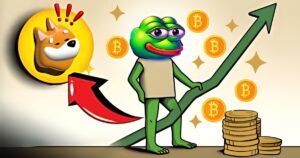Fans of memecoins and others who believe memes undermine the values and reputation of cryptocurrency are very different.
The unknown cryptographer who created Bitcoin, Satoshi Nakamoto, imagined a society in which people would be liberated from the oppressive governments and banks that had held them captive.
He most likely wasn’t prepared for the cryptocurrency market, which is rife with poorly designed tokens of dogs, cats, and frogs as well as racist memes.
It’s not surprising to see a heated discussion about the importance of memecoins to the cryptocurrency industry, given that coverage of the fourth Bitcoin halving has been swamped by a speculative frenzy in memecoins, including on the Bitcoin network itself.
Which we can respond to: their market capitalization currently stands at $51 billion.
A memecoin: what is it? The cryptocurrency “dumpster”
The recent spike of meme coins has left many loud detractors, including as well-known anonymous crypto blogger Polynya, frustrated and upset, claiming they have no place in the cryptocurrency ecosystem.
Polynya criticized memecoins as just a means of transferring wealth from the many to the most annoying people on the earth in his farewell Medium blog post, when he effectively gave up on cryptocurrency.
The expert emphasized tales of the nadir of the token form being a flood of racist memecoins, called “SlurFi” by others.
With 2024, racist, sexist, and other dickheaded memecoins have reached an all-time low.
This wickedness in crypto has now become commonplace and accepted. According to Polynya, this has come to define cryptocurrency: it may contain some valuable content, but it is primarily rife with frauds and utter degeneracy.
Memecoins are frequently managed by inexperienced entrepreneurs who have no idea what they’re doing, and they are also rife with scams, rug pulls, and malevolent taxation.
According to a recent Magazine analysis, nearly 91% of new Base memecoins had at least one security flaw, and 1 in 6 of them are blatant scams.
More than half of the presale tokens that were released on Solana between November and February were malicious, according to BlockAid.
Is the current memecoin degeneracy a factor in the abandonment of the business by real builders? The claim that nothing matters, everything in crypto is just a meme, and it’s “mid curve” to fund projects that genuinely have a purpose reflects a good amount of “financial nihilism.”
Memecoins are causing a degree of disenchantment and churn among cryptocurrency producers that is greater than even the last bear market, according to Michael Dempsey, managing partner of the venture capital firm Compound in New York.
It takes a lot of emotional work to build something of lasting value, and during a two-year bear market, it can be difficult to see a return of interest in cryptocurrencies, with gambling filling the main energy gap.
The long-term vision of cryptocurrency that has attracted so many investors, according to Eddy Lazzarin, chief technology officer of Andreessen Horowitz and another venture capitalist, is being undermined by memecoins.
Are memecoins worth their users’ and attention’s costs?

Memecoins aren’t all awful, though, if you can ignore the racist tokens, rug pulls, and con artists. Some claim that memecoins’ increased visibility is still beneficial to the cryptocurrency space. As traders rush to purchase and sell cryptocurrencies, blockchain networks will undoubtedly gain. A large wave of memecoin aficionados seeking an inexpensive means of exchanging coins is helping Solana, Base, and BNB Chain in particular.
Layer-1 blockchains Avalanche and BNB Chain have raised millions of dollars in recent months in an attempt to use the memecoin phenomenon to expand their networks.
A suggestion from the community for the Ethereum layer-2 network In addition,
Arbitrum is looking to raise a whopping $3.3 billion to let the memecoin floodgates open. It was completed in one hour, as befits a memecoin offer requesting billions of dollars.
According to 0xkawz, the creator of the memecoin fund concept, we see articles every day about how Solana memecoins move from 0-100M+ FDVs in a couple of days.
It’s difficult to disagree that Solana and, more lately, BASE have received all of the focus, they said, so there is no excuse why Arbitrum DAO shouldn’t at least attempt to spark a memecoin campaign.
Memecoin craze in Solana drives usage
Solana’s network activity momentarily eclipsed Ethereum’s in mid-March as speculators chased after the next big memecoin hit. According to DefiLlama, trading volume on March 15 exceeded its older and slower competitor by over $1.1 billion, with a total of $3.5 billion traded.
Up to 75% of all transactions failed at one time as a result of the frenzied activity testing the network’s scaling boundaries. A month later, a patch addressed this.
That same market is being targeted by BNB Chain, the preferred speculative degen blockchain from the last cycle. As part of its Meme Development Campaign, the chain said it will award developers who achieve a 30-day volume on the network exceeding $2 billion up to $1 million in April.
A BNB Chain representative states that memecoins
have the ability to attract more users to cryptocurrency regardless of whether they ultimately become just noise in the market.
According to Austin Federa, head of strategy at Solana, memecoins have gained popularity on the platform mostly because they have evolved into tokens that are essentially proxies for online communities and culture.
As an illustration, some memecoins, such as BONK, have united communities and created thriving ecosystems that have an impact on the larger cryptocurrency market.
This momentum is a result of Solana’s cost structure, which enables projects to send transactions and launch tokens at a low cost.
Millions get dependent on Base because of Memecoins

With its layer-2 network’s total value locked approaching $5 billion per L2Beat statistics, Coinbase’s Base network has also been a big beneficiary in the recent memecoin stampede.
Base founder Jesse Pollak stated, “There’s been a ton of energy on base,” at a presentation for a hackathon in New York on April 20. The talk was filmed again and uploaded to X.
The Base founder stated that although conjecture is fueling the activity,
he was particularly hopeful about one aspect of memes: the inventive methods in which meme communities have attempted to welcome new members.
According to Pollak, this is resulting in a type of Cambrian explosion of onboarding experiments where individuals are taking many shots in an attempt to figure out how to spread awareness of their culture.
We are more convinced than ever that these memes will play a major role in the millions of new recruits that these memes will bring to Base in the coming years, as they will consistently work to onboard new members in an incredibly inventive manner.
A Coinbase representative told Magazine that Base’s goal is to get the next billion users on-chain, and we are excited by the current surge of activity on Base.
According to Vitalik Buterin, memecoins can be beneficial
Ethereum co-founder Vitalik Buterin stated in a recent article on his website that while he has “zero enthusiasm” for coins named after scams, rug pulls, or totalitarian political movements, he sees interest in tokens that could fund significant public projects or even make it possible for individuals from lower-income countries to make a living.
Notoriety has it that Buterin’s purchase of Dogecoin in 2016 and subsequent sale in 2020 turned $25K into $4.3 million, making it one of his most profitable transactions to date.
Memecoins with practical applications
Memecoins, according to Thomas Tang, vice president of investments at cryptocurrency venture capital firm Ryze Labs, can be a “go-to-market strategy” for an organization or a business, transforming a token into a focal point for a community.
Tang gives the latest example of DEGEN on Base. It began as a tipping token that users on Farcaster’s Degen channel could use to give each other props for well-written postings, but it eventually developed into its own layer-3 chain.
On the basis of that, they constructed layer 3.
Late in March, the DEGEN chain—a layer-3 network built on top of Base—went live, with DEGEN serving as its native gas token.
According to the developers, the new chain would make it possible to test out payment methods, games, community incentives, and tipping. Up until now, it has primarily been utilized for speculating on meme coins, but on April 18, Degen’s activity reached 37.12 transactions per second, which makes it the quickest protocol in the Ethereum ecosystem. Rather than just technological capacity, demand plays a major role in determining the TPS of scaling solutions.
Communities for memecoin and dogecoin
Dogecoin (DOGE), according to CK Zheng, co-founder and chief investment officer of ZX Squared Capital, serves as a “good example” of a successful memecoin story. Zheng views memecoins as a product of the attention economy.
At first, nobody knew how Dogecoin would be used. However, when a community forms and a large network of people with shared interests comes together, things happen. Zheng emphasizes that a currency is merely a platform.
Some argue that memes drive all cryptocurrencies, even those claiming to have real utility.
Software developers Billy Markus and Jackson Palmer created Dogecoin in December 2013 to satirize the cryptocurrency speculation rampant at the time.
Dogecoin: From Memecoin to Mainstream Usage and Community Growth
Now, according to BitInfoCharts, Dogecoin holds a $26.7 billion market cap, making it the 8th most valuable cryptocurrency, just behind USD Coin (USDC), which has over 4.6 million non-zero addresses.
People use Dogecoin to pay for goods sold by Elon Musk’s Tesla, and there are signs that customers may eventually use it to buy entire cars.
Zheng pointed out that similar events occurred thousands of years ago when Chinese and ancient Roman traders met to conduct business along the Silk Road. He noted that gold served as a standard form of payment throughout generations of trade since no dollar or Chinese ¥ existed back then.
Dogecoin works the same way. When seven or ten million Dogecoin users come together, they form a community. As more participants join, a snowball effect occurs, driving up the value of the underlying asset.
A large portion of the population dislikes meme currencies, but many accept them because transparency and permissionlessness are core principles of cryptocurrency.
Without the ability to transact freely, what are memecoins?

Overall, I think meme currencies are beneficial because they demonstrate society’s dedication to protecting intellectual property rights via an open and free market, Coinbase technical lead Yuga Cohler stated in a March X discussion.
One of the purest ways for folks to exercise their right to freely deal without hindrance is with meme currencies.
Among them is Raj Gokal, co-founder of Solana, who has taken issue with venture capitalists who claim memecoins scare off “serious builders.”
Buterin continued in his blog post, “I value the desire of individuals to enjoy fun, and I prefer that the crypto space eventually flow with this direction rather than against it.”
Zheng, nevertheless, asserts that in the end, memecoins are really a “sideshow.”
According to Zheng, there is always a certain level of enthusiasm during cycles, and individuals take advantage of this to try out new ideas. She pointed out that NFTs had tremendous growth during the previous bull market.
In my opinion, Bitcoin is the main force behind the cryptocurrency ecosystem.

